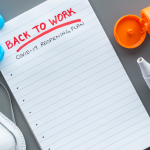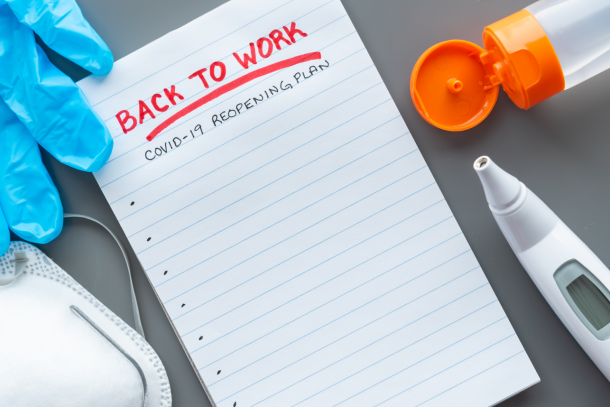Posted on March 1, 2021 in Cleaning

Return to Work Safely After Lockdown
The messaging sent to the different nations of the United Kingdom involving lockdowns, firebreaks and other measures to reduce the spread of Coronavirus is evolving.
However, the message tends to remain the same. Continue to work at home (where you can), do as much outside exercise as you want, but limit contact with others and try to limit travel.
Regardless of which nation you are based in, you should only be allowing staff to go back to work, if it is safe to do so. However with a vaccine, and a new four-step plan to ease England’s lockdown which could see all legal limits on social contact lifted by 21 June, you might asking yourself, what will my return to work look like? This question will depend on a number of factors, related to the industry you work in, where your staff are located, what your office environment looks like, among others.
Each business will need to consider how they will return to work and we should consider the following model to help us manage uncertainty and minimise harm.
How Can You Start Returning to Work?
You must make sure that your risk assessment for your business addresses the risks of COVID-19. It is about identifying sensible measures to control the risks in your workplace. Your risk assessment will help you decide whether you have done everything you need to. This is a 5 step process to safer working together:
- You have carried out a COVID-19 Risk Assessment and have shared the results with the people who work in your organisation
- You have cleaning, handwashing and hygiene procedures in line with government/NHS guidance
- You have taken all reasonable steps to help people work from home
- You have taken all reasonable steps to maintain a 2m distance in the workplace
- Where people cannot be 2m apart, you have done everything practical to manage the transmission risk
The guidance below will help you provide a framework for bringing your staff back to work safely.
The Prepare, Inform, Prevent, Recover Approach
To assist you we have developed the following guidance using the Prepare, Inform, Prevent, Recover (PIPR) approach.
1. Prepare:
Get ready to return to work and identify your return to work plan. This should include the following
- Leadership team discuss and agree the business return to work programme
- Plan to prepare your building for occupancy
- Arrange to conduct a preoccupancy inspection and arrange a pre-occupancy deep cleaning programme (Protech Property Solutions can help here if required)
- Train your FM and cleaning teams on good hygiene matters and establish a daily cleaning schedule
- Review any service which may present a health issue and establish how you can minimise risk
- Test all emergency and life safety systems
Agree who will return to work and consider the following:
- Workplace distancing and space availability
- Work routines to achieve workplace distancing
- Vulnerable or at risk staff
- Staff who have child or care responsibilities
- Travel arrangements to, where possible, reduce the need for public transport
Establish workspace distancing protocols based on Government advice. This should be considered for the following:
- Staggered arrival and departure
- Building entrance and/or exit protocols
- Workspace
- Pantries and any space where food is prepared and eaten
- Meetings internal
- Meetings with clients
- Security and Emergency arrangements
You also need to consider the consequences of increased anxiety caused by how the return to work may lead to workplace aggression and/or violence.
And importantly, establish a protocol to respond to expected spikes in the outbreak. This will ensure a quick response if you need to send your team home, you can do this effectively without disruption to service.
2. Inform:
Establish a return to work program and establish who will communicate with staff. The more senior the person, the better.
Arrange a welcome back to work program for staff and managers, to inform them of the ‘new’ workplace protocols. This includes:
- Workplace distancing protocol and building cleaning arrangements
- Travel and arrival arrangements
- This is particularly important for those who cycle to work or use changing facilities
- Relaxation of car share program, if in place
- Follow Government advice on use of public transport
- Working arrangements including breaks
- Seating arrangements
- Workstation health and hygiene requirements
- Eating and drinking and use of fridges for personal food
- Ill-health reporting and staff support program
- End of day protocols, where an alternative team may be working on site
- Travel to and from client sites or meetings
- Vehicle hygiene requirements and checks
And keep reinforcing your health and hygiene messages as ultimately, they will keep people healthy and safe.
3. Prevent:
Ensure that health and hygiene is managed and maintained by:
- Identifying key touch points in the workplace and providing appropriate sanitation stations to allow hands to be cleaned
- Washroom cleanliness
- Determining cleaning frequencies which need to consider an initial clean of surfaces and HVAC system
- Cleaning to consider core activities and staff provided with appropriate PPE and be visible to staff during the working day
- PPE is recommended for psychological control, rather than a safety measure
- Ensuring statutory testing is undertaken safely
- Reviewing:
- Food preparation and server areas to ensure workspace distancing can be maintained
- Deliveries
- Waste Arrangements included specific arrangements for PPE worn by cleaners and FM Staff
- Cycle to work arrangements and changing facilities where provided
- Reinforcement of workplace distancing protocols
4. Recover:
The business recovery is a key stage. Leaders should monitor the effectiveness of the return to work program to ensure that it remains effective and is supporting those who have returned to work. It can also be used to restore confidence in the business.
Review lessons learnt from the outbreak and ask for feedback. Critique what you’ve learnt and use this to improve.
Review and update your Business Continuity Plan. Most organisations will have had their plan activated by the outbreak so we would encourage you to learn from this.
Finally, review what you’ve learnt from the period of time people have been working from home. Are there positives to be had? We believe that lockdown has reconnected families and given people time look at what’s important to them, so it might be time to look at how teams work in a different way!
The above should bring some structure to your return to work program but, there’s lots more to consider. For help managing your return to work process, take a look at our return to work checklist which considers the below areas when planning your return to work process:
- Organisation
- Overall
- Safety/Security systems
- Facilities
- Planning
For help and advice on deep disinfection cleaning please call one of our friendly team on 0845 604 1288 or visit Disinfection Cleaning Services.
Categories
- Building Maintenance
- Cleaning
- Electrical
- Gardening
- General Info
- Our Service
- Pest
- Security
- Uncategorized
- Waste Solutions
Archive
- April 2024
- March 2024
- February 2024
- January 2024
- December 2023
- November 2023
- August 2023
- April 2023
- February 2023
- January 2023
- December 2022
- November 2022
- October 2022
- September 2022
- August 2022
- July 2022
- June 2022
- May 2022
- April 2022
- March 2022
- February 2022
- January 2022
- December 2021
- October 2021
- September 2021
- August 2021
- July 2021
- June 2021
- May 2021
- April 2021
- March 2021
- February 2021
- January 2021
- December 2020
- November 2020
- October 2020
- September 2020
- August 2020
- July 2020
- June 2020
- May 2020
- April 2020
- March 2020
- February 2020
- January 2020
- December 2019
- November 2019
- October 2019
- September 2019
- August 2019
- July 2019
- June 2019
- May 2019
- April 2019
- March 2019
- February 2019
- January 2019
- December 2018
- November 2018
- October 2018
- September 2018
- August 2018
- July 2018
- June 2018
- May 2018
- April 2018
- March 2018
- February 2018
- January 2018
- December 2017
- November 2017
- October 2017
- September 2017
- August 2017
- July 2017
- June 2017
- May 2017
- April 2017
- March 2017
- February 2017
- January 2017
- December 2016
- November 2016
- October 2016
- September 2016
- August 2016
- July 2016
- June 2016
- May 2016
- April 2016
- March 2016
- February 2016
- January 2016
- December 2015
- November 2015
- October 2015
- September 2015
- August 2015
- July 2015
- June 2015
- May 2015
- April 2015
- March 2015
- February 2015
- January 2015
- October 2014
- May 2013
- April 2013
- November 2011
- September 2011
- June 2011
- January 2011
- December 2010
- November 2010


